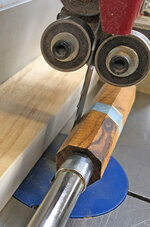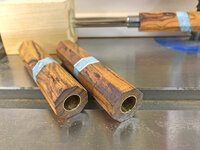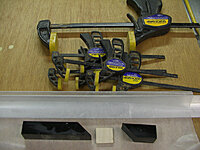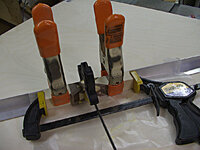Greetings from
Nebraska! For clamping materials (wood, stone composites, metal) with those angle cuts I've had good success recently. These are the steps that I take:
1) I make sure the non-metals are the same size before cutting. I true up my wood blank so that it matches the dimensions of the stone blank I will be using as a segment.
2) I keep the metal exact size or a little under sized. I do this by essentially cutting the other materials first and then using the cut surface to measure and mark the metal before I cut it.
3) I keep the metal as flat as possible when cutting it. I use some bits of wood, clamps, and a utility knife to score the metal and break it rather than using shears as shears usually cause the edges of metal to curve when it is being cut. If the metal isn't flat, then I squash it in a vise or pound it flat with a hammer on an anvil. Just as with tubes, I scuff the surfaces of the metal with sandpaper to promote adhesion when gluing.
4) I use epoxy. Nearly all of my segmenting failures have been on blanks that I used CA on. I use epoxy, spread evenly, and allowed to fully mature (overnight).
5) I clamp on both the sides and on the ends of the blank. The uniform size of blank (#1, and #2) permits me to use bits of wooden outside corner molding (90 degree angle) to clamp across the outside corners of the blank to keep the angled segments from sliding. I then use an "F" style clamp to apply end-to-end pressure for squeezing the angled segments tight for curing.
6) I drill carefully, using a sharp drill that is best suited for the materials being drilled. For example, I use a carbide bit for drilling segmented blanks that contain stone composites. Also use drill to minimize heat buildup in the blank. My rule of thumb has been to never drill to a depth of more than 3 times the diameter of the bit before retracting the bit to clear the flutes and to give both the blank and the bit time to cool. I also use "BladeCoat" or "DriCoat" blade and bit lubricant on my bit when drilling. I also cut my blanks long so that any chip-out when the bit exits the blank can be either cut off or sanded off when the ends are being squared to the tube.
7) I use epoxy to glue the tubes in. There are a lot of blowouts during turning that can be attributed to insufficient coverage, i.e. areas of poor or no adhesion between the tube and the blank. Let the epoxy fully cure before starting to turn (overnight).
8) I use a jig and bandsaw to saw the corners off before turning. This not only removes excess material in a less stressful way than turning, but also reduces (or changes) the type of stresses between the tool, the blank, the tube, and the mandrel (if used) when turning. Turning the corners off causes an impact type of stress that works against the tensile strength of the glue. This is much different than the steady stress that results from turning after the blank is round. The corners can also be sanded off or routed off as well. There are lots of commercial jigs available to help with this task. This is the homemade "Corner-b-gone" that I use. It not only cuts the corners off, but it cuts with reference to the tube so the shape is symmetrical. Using the bushings on the blank also lets me adjust the cut depth to reduce the bulk of the material beyond just rounding the corners off as the flats are cut as well (All 8 sides of the blank get cut).

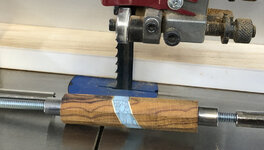
Regards,
Dave
 . I may try cutting across the blank in a U shape or maybe a V. That will give it a wedge shape where I can clamp on the ends and it can't slide apart.
. I may try cutting across the blank in a U shape or maybe a V. That will give it a wedge shape where I can clamp on the ends and it can't slide apart.


